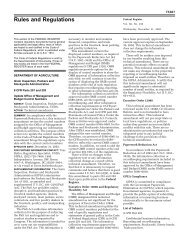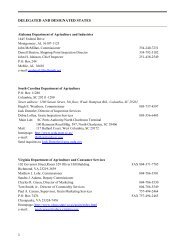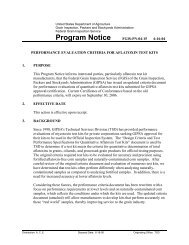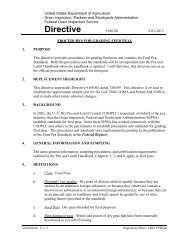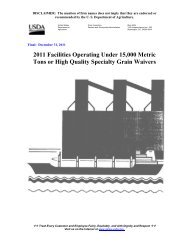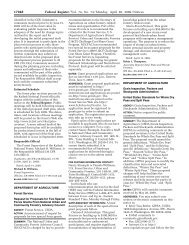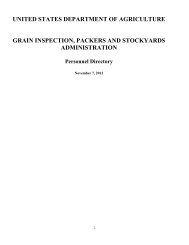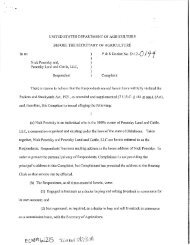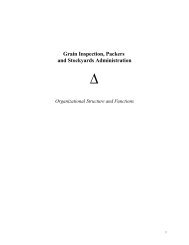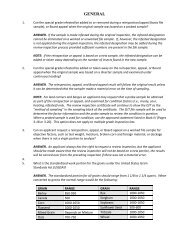Assessment of the Cattle and Hog Industries Calendar Year 2000
Assessment of the Cattle and Hog Industries Calendar Year 2000
Assessment of the Cattle and Hog Industries Calendar Year 2000
You also want an ePaper? Increase the reach of your titles
YUMPU automatically turns print PDFs into web optimized ePapers that Google loves.
On many occasions, <strong>the</strong> public has expressed its belief that USDA may restrict<br />
meatpackers’ behavior, without specific evidence <strong>of</strong> competitive harm. P&SP must<br />
prove any allegation <strong>of</strong> a prohibited anti-competitive practice in a litigated case by<br />
proving through a preponderance <strong>of</strong> <strong>the</strong> evidence that some measurable harm has<br />
occurred or is likely to occur. Most issues regarding competition <strong>and</strong> potentially anticompetitive<br />
practices are complex <strong>and</strong> interrelated. They <strong>of</strong>ten do not yield to easy<br />
answers. Extensive data collection <strong>and</strong> sophisticated economic analyses are required to<br />
fully underst<strong>and</strong> <strong>the</strong> reasons for <strong>and</strong> implications <strong>of</strong> <strong>the</strong> practices.<br />
Packers Acting in Concert to Restrict Competition–Members <strong>of</strong> <strong>the</strong> industry,<br />
especially producers, express concerns about possible concerted action by meatpackers.<br />
In some cases, concerns are expressed about wide-ranging impacts cutting across broad<br />
industry segments, such as allegations <strong>of</strong> packer behavior leading to low hog prices<br />
during December 1998-January 1999. In o<strong>the</strong>r cases, concerns address specific<br />
circumstances involving narrow industry segments, such as why few packers bid on cattle<br />
at a particular feedlot. These concerns do not necessarily suggest firms are engaging in<br />
unlawful practices <strong>and</strong> instead may be attributable to normal supply <strong>and</strong> dem<strong>and</strong> forces,<br />
competitive bidding processes, or personal relationships that have developed over time<br />
between packers <strong>and</strong> livestock sellers. The P&S Act prohibits unlawful conspiracies,<br />
combinations, or agreements that result in certain anti-competitive activity. 96 Past<br />
analyses by P&SP <strong>of</strong> packers’ livestock procurement patterns have not revealed such<br />
activity among packers.<br />
Short Trading Window–A specific practice that raises concerns is <strong>the</strong> allegation that<br />
<strong>the</strong>re is a short window during which trading <strong>of</strong> fed cattle occurs. Some cattle producers<br />
<strong>and</strong> market observers contend that virtually all spot-market cattle transactions occur<br />
during a relatively short period each week, <strong>of</strong>ten described as a 15- or 30-minute window.<br />
During its 1996 Texas Panh<strong>and</strong>le Fed <strong>Cattle</strong> investigation, P&SP found that <strong>the</strong> highest<br />
volumes <strong>of</strong> cattle were purchased on Wednesdays, but spot-market transactions occurred<br />
on every business day <strong>of</strong> <strong>the</strong> week. As discussed previously, <strong>the</strong> bidding process for fed<br />
cattle normally begins early on Monday mornings when packer buyers visit feedlots to<br />
view cattle for sale. The price discovery process continues during <strong>the</strong> week as buyers <strong>and</strong><br />
sellers presumably assess market conditions, followed by rapid consummation <strong>of</strong> many<br />
transactions once market participants believe <strong>the</strong> market price has been discovered.<br />
Shared Agents–It is a common practice for one buyer to represent more than one packer<br />
at an auction sale, especially in sales involving cull livestock. Auction market owners<br />
<strong>and</strong> livestock sellers have raised concerns that <strong>the</strong> use <strong>of</strong> common buyers, or shared<br />
agents, reduces <strong>the</strong> number <strong>of</strong> competing buyers. This practice has <strong>the</strong> potential for<br />
reducing competition. However, <strong>the</strong> issue is complicated by a general lack <strong>of</strong> buyers at<br />
many auctions. Sharing a buyer may result in packers purchasing livestock at auctions<br />
where <strong>the</strong> packers o<strong>the</strong>rwise would not be active. P&SP continues to investigate<br />
complaints about shared agents at livestock markets.<br />
96 7 U.S.C. 192<br />
30



